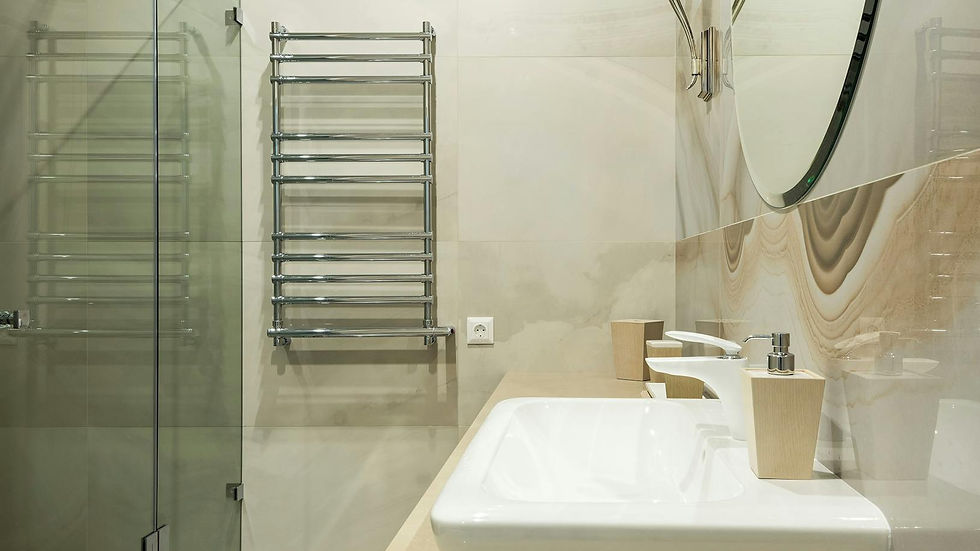Bathroom Countertop Depth: The Complete Guide
- Riley Thorne

- 1 day ago
- 4 min read

Tired of bumping elbows while brushing your teeth or constantly knocking over your toiletries in the bathroom? The problem might not be your habits, but the depth of your bathroom countertop. A well-chosen countertop depth can drastically improve the functionality and comfort of your bathroom space. This complete guide dives deep into everything you need to know about bathroom countertop depth, ensuring you make an informed decision for your next renovation or build. We'll cover standard sizes, factors influencing your choice, and expert tips for maximizing space and style.
Understanding Standard Bathroom Countertop Depths
Bathroom countertop depth explained can seem complicated, but it boils down to a few common measurements. The standard depth for bathroom countertops typically falls between 19 and 25 inches. This range accommodates most sink sizes and allows comfortable reach for everyday tasks. However, variations exist to suit different bathroom layouts and personal preferences.
Common Depth Measurements
Within the 19-25 inch range, certain depths are more prevalent. A 22-inch depth is a frequently chosen option, offering a good balance between space efficiency and usability. 24 or 25-inch depths provide more room for larger sinks and storing toiletries, but might not be ideal for smaller bathrooms. Conversely, 19 or 20-inch depths are suitable for very compact spaces where maximizing floor area is crucial. These shallower depths often require smaller sinks or wall-mounted faucets to maintain functionality.
Minimum Depth Considerations
While standard depths offer a starting point, it's crucial to consider minimum depth requirements. Plumbing codes often dictate minimum clearances around sinks. Even without strict codes, ensuring enough space for comfortable use is essential. A countertop that's too shallow can lead to water splashing, difficulty cleaning, and an overall cramped feeling. Generally, aim for at least 19 inches to accommodate a standard-sized sink and allow some working space.
Factors Influencing Your Countertop Depth Choice
Selecting the right bathroom countertop depth involves considering several factors beyond just standard measurements. Bathroom size, sink type, and personal needs all play a significant role in determining the ideal depth for your space. Ignoring these factors can lead to a dysfunctional and frustrating bathroom experience.
Bathroom Size and Layout
The dimensions of your bathroom are paramount. In a small bathroom, a shallower countertop is often necessary to maximize floor space and prevent the room from feeling cramped. Conversely, larger bathrooms can accommodate deeper countertops, providing ample storage and workspace. Consider the overall layout, including door swing, toilet placement, and shower or tub location, to ensure the countertop doesn't impede movement.
Sink Type and Size
The type and size of your sink directly influence the required countertop depth. Undermount sinks, which sit beneath the countertop, require less depth than vessel sinks, which sit on top. Larger sinks, regardless of type, necessitate deeper countertops to provide adequate surrounding space. Carefully measure your sink and consider its placement on the countertop to determine the minimum depth required. A good rule of thumb is to leave at least 4 inches of countertop space in front of the sink.
Personal Needs and Storage Requirements
Consider how you use your bathroom and your storage needs. If you require ample counter space for applying makeup, styling hair, or simply keeping toiletries within reach, a deeper countertop is a better choice. Think about the items you typically store on the countertop, such as soap dispensers, toothbrush holders, and decorative items. Ensure the chosen depth provides enough space to accommodate these items without overcrowding the surface. Families with multiple users might also benefit from a deeper countertop to accommodate everyone's belongings.
Tips for Maximizing Space and Style
Choosing the right depth is only part of the equation. Optimizing the space and style of your bathroom countertop involves strategic design and storage solutions.
Space-Saving Strategies
Wall-mounted faucets: These free up valuable countertop space behind the sink.
Corner sinks: Ideal for small bathrooms, they maximize space utilization in tight corners.
Floating vanities: These create the illusion of more space by leaving the floor visible.
Built-in storage: Incorporating drawers or shelves into the vanity provides concealed storage and keeps the countertop clutter-free.
Style Considerations
The depth of your countertop can impact the overall style of your bathroom. A deeper countertop can create a more luxurious and spa-like feel, while a shallower countertop can contribute to a more minimalist and modern aesthetic. Consider the material and edge profile of the countertop, as these can also influence the perceived depth. For example, a thicker countertop with a rounded edge will appear more substantial than a thinner countertop with a sharp edge.
Industry Best Practices
Professionals recommend prioritizing functionality and usability when determining bathroom countertop depth. Consult with a bathroom designer or contractor to get personalized advice based on your specific needs and bathroom layout. Always factor in plumbing requirements and accessibility considerations. Ensure the chosen depth complies with local building codes and allows for comfortable use by all members of your household.
Conclusion
Choosing the right bathroom countertop depth is a critical decision that impacts both the functionality and aesthetics of your bathroom. By understanding standard depths, considering factors like bathroom size and sink type, and implementing space-saving strategies, you can create a bathroom that is both beautiful and practical. Remember, bathroom countertop depth explained doesn't have to be confusing!
Key takeaways: Assess your space, understand your sink requirements, and prioritize your personal needs. Don't hesitate to seek professional guidance to ensure you make the best choice for your home. Ready to transform your bathroom? Start by measuring your space and considering your storage needs. With this complete guide, you're well-equipped to make an informed decision and create the bathroom of your dreams!



Comments